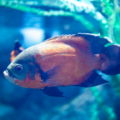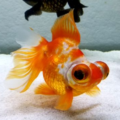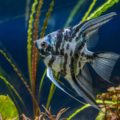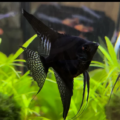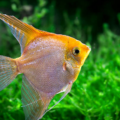All the premium care requirements for maintaining the striking contrast of the Half Black Angelfish’s dual tone skin and sensitive fins.

Unveiling the Half Black Angelfish
Have you ever seen a dual-toned Angelfish and wondered about the story behind its unique coloration? This guide contains all Half Black Angelfish Essentials necessary for keeping one of these exotic freshwater fish in your aquarium.
This unique variety is more than its two-toned color pattern, even though that’s its most striking feature. It also has the triangular shape of the South American angelfish and surprisingly simple care requirements.
If you want to keep this striking fish in a community tank or breed it alone, then keep reading. We’ll start this guide with some origin and breeding insights to prepare you for your new pet.
Origins and Breeding Insights
Unlike basic single-toned angelfish born in the wild, the Half-Black angelfish’s origins can be traced back to careful selective breeding by fish traders in the 20th century. They sought new color variations of the beloved triangular freshwater fish and stumbled on this unique angelfish development.
Although the Half-Black Angelfish isn’t the only discovery of that era, it’s the focus of this guide.
Breeding Insights
Today, fish traders still experiment with angelfish genetic selection by breeding different fancy fish to create new variants. However, the Half-Black species remains one of the discoveries of the late 20th century that stands to the test of time.
If you want to keep the Half Black Angelfish in your aquarium, there are two options. You may choose to go the selective breeding route and start from the egg stage or get the grown and matured adults.
Whichever choice you make, I’ve got you. However, let’s take a look at why the Half-Black Angelfish is worth a second glance.
Distinctive Physical Characteristics

Its distinctive fish appearance is half black and other solid colors like white, silver, or yellow. The distinction between the black side and lighter tone varies from blended to sharp lines depending on your fish’s pigmentation, but you can’t miss the sharp color contrast.
As for the size, Half Black sometimes has the same Angelfish body structure, which is a lateral triangle shape with long flowing fins and a final height and length of 6 x 8 inches .
Seeing these Half-Black Angelfish traits, it’s easy to see why it remains one of the top picks for fancy tanks and why it needs specialized care and maintenance.
Specialized Care and Maintenance
This guideline on Half Black Angelfish care helps you avoid rookie mistakes when keeping this unique freshwater fish. Remember that it has sensitive fins and a different body shape, but it also has a rare coloration that needs specific attention to ensure its vibrancy.
Your pets’ needs are twofold: water quality in the Angelfish tank environment and health care.
Water Quality
As an aquarium owner, you’re taking your Half Black Angelfish away from its natural habitat to a foreign space. So, you must ensure it has the best living conditions, starting with its environment.
Besides keeping this species in clean, filtered water, you must also ensure the parameters are ideal. As a freshwater fish, your Half Black Angelfish survives in cool water with a temperature between 76-82℉ and a pH level of 6.5- 7.5, making it slightly acidic.
We recommend using a master test kit like the one form amazon linked below to frequently test your water parameters.
Health Care
You must change 20-30% of the water weekly to maintain cleanliness in the tank because leftover food particles can lead to health complications.
Another underrated aspect of health care is protecting your Half-Black Angelfish’s emotional and mental well-being.
Don’t place them in high-stress tanks that’ll bring out the worst side of their personality. More on this later, but first, here’s a closer look at the ideal habitat for your pet.
Ideal Habitat Configuration
Based on the origin story I told you earlier, you know that the Half Black Angelfish habitat is the Amazon River in South America.
So, when building your aquarium, don’t focus only on the best tank conditions for health care. Also, consider the need for a familiar space to feel safe and grow at a normal pace. The best way to do that is by using the ideal aquarium decorations.
No idea what those are? Here’s your answer —
Tank Size
Get a tall tank because of your pet’s triangular body, and ensure it holds at least 30 gallons of water per Half Black Angelfish.
Lighting
Create a routine for your pets to allow them to sleep and wake up normally by using a 12-hour light system. This means that you can’t leave the light on all the time just to admire your Half-Black Angelfish because that’s harmful to their mentality.
Substrate and Decor
Here’s where you put your design skills and history knowledge to the test. Add smooth pebbles for a touch of modernity, sand, fine gravel, and granite for a traditional look.
Use plants, driftwood, smooth rocks, and caves to replicate the Amazon in your minute tank. Avoid sharp edges that can cut your pet’s fins and skin.
Filtration System
You need well-oxygenated water in your tank to ensure the nitrogen cycle completes its process every time. Use a single or double canister filter to reduce waste and convert leftover food that causes ammonia into nitrite and nitrate without disturbing the oxygen flow.
Feeding and Nutritional Needs

When feeding your Half-Black Angelfish, you must create a diet filled with foods known for enhancing angelfish coloration. That doesn’t mean you should compromise on other nutritional needs.
You must strike a balance with all the food types you use during Half-Black Angelfish feeding. How can you mix a balanced diet for vibrant angelfish? By capitalizing on their omnivorous nature.
This species eats live animal food and plant matter, so feeding it is easy.
Here are some foods you can feed them:
- High-quality pellets and flakes commercially made for vibrant fish.
- Animal food like Bloodworms, Brine Shrimp, and Daphnia, whether frozen or alive.
- Vegetables like blanched peas, spinach, and algae wafers aid digestion.
The best part about adding live animal food to your Half-Black Angelfish diet is that it stimulates your pet’s natural hunting needs. So, even in captivity, it acts normal.
For more on feeding your aquatic pets check out The Ultimate Guide to Fish Food: Pros and Cons & Best Choices!
Feeding Frequency
I recommend incorporating feeding routines for health and not as a punishment. Feeding once to twice daily in portions they can finish in under 3 minutes is the best.
If you allow your pets to eat sporadically, it’ll lead to waste, indigestion, and aggression, all of which you can’t afford to allow if you want healthy Half Black Angelfish.
Health Monitoring and Disease Prevention
This is where I warn you to turn back and stop reading if you don’t have time for the health management of your pet because it’s no walk in the park. Your Half-Black Angelfish’s health depends on how well you handle its care requirements.
Following the guidelines I’ve listed (scroll to the top for a refresher course) is your best bet for disease prevention. However, there are still certain illnesses your pets may contract due to genetics, environmental changes, and contact with new fish. Here’s how to manage them:
Monitoring Health Changes
Observe your fish every day, preferably during feeding times, for any behavioral and physical changes.
If they’re typically friendly and they’ve suddenly become shy, it’s a sign. If they lose their appetite, then there’s a problem. If they lose weight or have discolored skin, look closer.
Also, test the water with a thermometer and other units to ensure it’s always at an optimal level. Ensure the parameters are stable and there’s no sudden change to disrupt your pet’s normalcy.
Common Diseases and Their Causes
- Fin Rot: Fraying, Clamped, or Decaying Fins is a result of poor water quality.
- Ich (White Spot): Grainy, white, salty cysts on the body caused by bacteria in the water.
- Dropsy: swollen bodies causing difficulty in swimming due to bacterial infection, overfeeding, and indigestion.
Disease Treatment
The immediate treatment for most of these diseases is to increase the water temperature after changing it to speed up the life cycle of infectious bacteria.
Use antibiotic or antibacterial creams and medication for bacterial infections. Antifungal creams for fungal infections and copper-based treatment for velvet or white spot disease are also used.
Quarantine new fish before introducing them to the main tank and isolate infected fish for treatment to prevent the spreading of the disease.
If you’re unsure of your pet’s illness, visit a certified vet for diagnosis. Monitoring health changes is tasking, but it can be easier if you dedicate yourself to it and schedule periodic checkups with a fish vet.
Breeding Half-Black Angelfish

If you chose to start from the egg to adult stage, then here are some relevant insights for breeding Half Black Angelfish –
Breeding Pairs
You must capitalize on the genetic factors when breeding your pets, so carefully select adult male and female breeders. Check for physical and latent defects to avoid reproducing damaged Half Black Angelfish or a new variant unless you don’t mind.
Typically, this species forms monogamous pairs once they’re older than 6-12 months. If they don’t pair naturally, you must find compatible duos based on size and temperament.
This video has been very helpful in identifying the sex of angelfish, I highly recommend it:
Breeding Tank
Get a separate breeding tank for your new pets, but maintain the same requirements from the size (35 gallons) to water quality and substrates. The only addition is a flat surface or spawning mop for laying the egg.
Reproduction (Spawning)
The male Half Black Angelfish and the female start courtship by swimming together and then rubbing against each other. After this, the female will go into the cave to lay her eggs.
Then, the male will fertilize it externally, which causes a sticky membrane that turns the transparent eggs into an orangish color.
In the two to three days the eggs take to hatch, the parents guard them and fan them with their fins for oxygen.
Angelfish Fry and Egg Care
Raising Angelfish fry is more sensitive than caring for adults. Within 3 – 5 days, the hatched eggs will become free-swimming and need food for survival. They’ll first feed on their yolk sac from their eggshell, and then you must feed them infusoria.
As they grow older, add crushed flakes, baby brine shrimp, and powdered food to their diet, then separate the larger Half Black Angelfish from the smaller ones. You may move them to a grow-out tank until they’re large enough to swim with the adults without looking like prey.
At this stage, they’re prone to fungal diseases, so ensure that the water quality is optimal to prevent infection.
If you follow the steps in this part, I can assure you of the successful reproduction of Half Black Angelfish.
I’ve mentioned predation and aggression a few times while explaining the Half-Black Angelfish behavior in certain conditions, but that’s not the entirety of their personality.
Although this species is territorial during breeding and feeding, it’s actually quite social.
Your Half-Black Angelfish adds interesting social dynamics in aquariums because they do well in pairs and groups even though they lead. Just ensure there’s a hiding spot for them to seek solace when they feel overwhelmed and need privacy.
Tank Compatibility for Half Black Angelfish
When planning a community tank integration of your pet with other species, you must check certain factors.
- Do they have the same temperament?
- Are they the same or similar in size?
- Do they have the same care requirements?
If your answer is yes all around, then go ahead. If not, abort the mission.
Some compatible pairs for harmonious fish interactions with your Half Black Angelfish include Tetras, mid-sized Cichlids, and Corydoras.
Conclusion
It’s time to wrap up this Half-Black Angelfish Care guide and say goodbye. I believe I’ve convinced you that there’s more to this unique freshwater fish than aquarium beauty enhancement.
You already have premium fish care insights if you decide to add this beauty to your tank. But let’s see if you remember everything you’ve learned –
- What’s the ideal water parameter for the Half Black Angelfish?
- What kind of food do they eat?
- How can you treat their disease?
- Are they social?
If you can answer those questions, you’ll be ready to set up your Half-Black Angelfish aquarium, and I’m excited for you!


